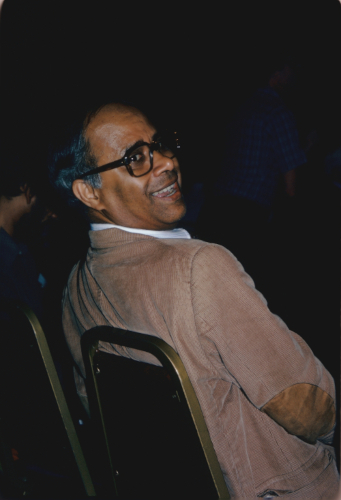 Mukul R. Kundu at the 1981 URSI Meeting, Washington DC. Photo credit: Sullivan NRAO/AUI/NSF.
Mukul R. Kundu at the 1981 URSI Meeting, Washington DC. Photo credit: Sullivan NRAO/AUI/NSF.
Mukul R. Kundu
Contributed by Nat Gopalswamy
Mukul Kundu was a renowned solar physicist and radio astronomer, who worked all his life on problems in the radio physics of the Sun. His work significantly advanced the understanding of the interaction between accelerated electrons and the magnetized solar corona that resulted in a myriad of non-thermal radio phenomena. Mukul was a Fellow of the Royal Astronomical Society.
Mukul was born 10 February 1930, in Kolkata India. Completing his college studies in Physics and Radio Physics in India at the University of Calcutta, Mukul went on to earn his DSc degree in Radio Astronomy from the University of Paris in 1957. Mukul's early work involved the study of the terrestrial ionosphere and how it is influenced by the Sun. He was also involved in the development of radio interferometry when he was in Paris. After a brief stay at the National Physical Laboratory ( New Delhi) in India, he went to the United States first as an Associate Research Physicist at University of Michigan and then as an Associate Professor Cornell (1962-1965). He returned to India to work at the Tata Institute of Fundamental Research for a three-year period before returning to the United States as a Professor at the University of Maryland, College Park, where he worked until the last day of his life.
The radio interferometric work he began during his graduate days became his prime interest in studying solar phenomena at various wavelengths, ranging from millimeter to meter waves. His discovery of the polar cap brightening in 1971 with Timothy McCullough has had a lasting impact on the connection between the solar wind and the surface features on the Sun (Kundu and McCullough, 1972). The polar cap brightening was later found to be associated with coronal holes in the solar polar regions as well as at low latitudes. The enhanced radio emission indicates that the chromosphere under coronal holes has different physical conditions compared to the quiet chromosphere. At the other extreme of radio wavelengths, his early argument that the non-thermal electrons responsible for the complex type III solar radio bursts observed at kilometric wavelengths is from the flare site rather than due to shock acceleration has proved to be of enduring usefulness (Kundu and Stone, 1984). Mukul has done extensive work on solar radio phenomena using interferometric arrays such as the Clark Lake Multi-frequency Radioheliograph, the Nançay Radioheliograph, and the Nobeyama Radioheliograph, the Westerbork Synthesis Radio Telescope (WSRT), the Very Large Array (VLA), and the Berkeley-Illinois-Maryland Array (BIMA).
Mukul authored or co-authored more than 400 research publications mostly on the Sun, but a significant number in other areas of astrophysics: radio galaxies, supernova remnants, nebulae, flare stars, and T-Tauri stars. Mukul published his famous text book Solar Radio Astronomy in 1965 and was talking about an updated version, which never materialized. He also edited four other books covering solar physics, solar radio physics, solar terrestrial physics, and astrophysics.
Mukul was a member of the editorial board of the journal Solar Physics for more than forty years – from 1967 until his death. He contributed significantly to the success of the research associate program of the National Academy of Sciences (National Research Council) for nearly two decades. He also served as a member of National Science Foundation's Advisory Panel for Atmospheric Sciences (1983-86). Mukul also trained numerous students and young scientists from the US and abroad.
A great fan of food and wine, Mukul was a regular visitor to the Washington, DC, waterfront to get fresh fish. A jovial person, he enjoyed the company of his colleagues and will always be remembered for his healthy laugh, which identified him in any group conversation or at any dinner table.
Mukul R. Kundu died on 17 June 2010.
![[IAU logo]](iau_wb_thumb.jpg)
![[URSI logo]](URSI-logo-thumb.jpg)
![[Karl Jansky at his antenna]](jansky_photo_02_thumb.jpg)
![[Reber's Wheaton antenna]](Reber_Telescope_Wheaton_thumb.jpg)
![[Dover Heights]](Dover_Heights_02_thumb.jpg)
![[4C telescope]](GB61-195_4C_telescope_thumb.jpg)
![[Ewen and horn antenna]](ewen_horn1s.jpg)
![[Dwingeloo, 1956]](Dwingeloo-1956-thumb.jpg)
![[Jocelyn Bell Burnell and Cambridge antenna used in pulsar discovery]](burnell2_thumb.jpg)
![[Lovell Telescope at Jodrell Bank]](site_1594_0001-500-334-20180316163019-thumb150.jpg)
![[Wilson, Penzias, and Bell Labs horn antenna]](wilson-penzias-horn_thumb.jpg)
![[6-m Millimeter Radio Telescope in Mitaka, Japan]](6m-thumb.jpg)

